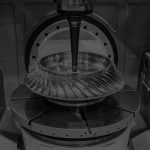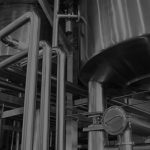Like other synthetic fibers, polyester fibers are produced by industrial methods. In terms of properties, they are considered a suitable alternative to natural fibers, such as cotton. To manufacture this product, the chemical composition of Dimethyl Terephthalate (or its substitute. Terephthalic Acid) and Monoethylene Glycol is used. First, these chemicals are converted into PET polymer in the vicinity of suitable catalysts. Then, the PET polymer is converted into fiber while passing through spinnerets under the influence of cold air. Next, the fibers form a bundle. Finally, after being stretched and heat-treated, and once the molecular orientation and thermal stability are reached, the bundle is cut into staples (short-cut fibers) in desired sizes and then baled.
Currently, with a production capacity of about 36,000 tons/year, the polyester plant produces polyester fibers with 1.4 and 3.3 detoxes and a cut length of 38 mm (the plant also can produce fibers with the linear densities of 2.1 and 1.6 dtex) which are packed in bales of 250 to 300 kgs after all the parameters are tested and approved by the laboratory Ultimately, they are delivered to consuming units, such as spinning or non-woven fabric manufacturing units, to produce woven (warp-and-welt) fabrics for clothes, bed sheets, etc., as well as to manufacturers of non-wovens and bedclothes.
Polyester fibers have significant characteristics, i.e., high durability, abrasion resistance, lightfastness, chemical resistance (e.g. resistance to bleaches), and proper dimensional reversibility and stability, which makes the final products more durable. Polyester, because of its specific chemical structure, is crystalline; furthermore, owing to the absence of active groups in its polymer and the low moisture absorption, it is highly resistant to most chemicals. The other significant properties of these fibers are colorfastness and no need for ironing. In addition, they are resistant to boiling and weak acids, as well as strong and cold ones and dilute alkalies have no effects on them, whereas hot and strong alkalies would damage them. The physical properties of these fibers can vary in accord with the needs of the market and consuming units. Such fibers are used, either purely or mixed with other fibers, namely cotton, viscose, and wool, in the preparation of various threads and fabrics for curtains, shirts, circle weaves, bed sheets, carpets, different types of filters and waddings, conveyor belts, tarps, various types of ropes, and bedclothes, such as quilts, pillows, etc. Polyester fibers are produced and supplied in many countries under different brand names, such as Terylene in England, Trevina in Germany, Tergal in France, Tetron in Japan, Terital in Italy, and Dacron in the United States.
Polyester Poy (Polyester Yarn)
Like other synthetic fibers, polyester fibers are produced by industrial methods. In terms of properties, they are considered a suitable alternative to natural fibers, such as cotton. To manufacture this product, the chemical composition of Dimethyl Terephthalate (or its substitute. Terephthalic Acid) and Monoethylene Glycol is used.
Reviews
There are no reviews yet.














Reviews
There are no reviews yet.